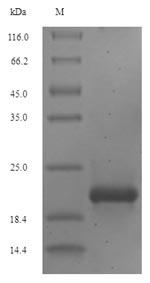Discover our premium-quality Recombinant Human Proepiregulin (EREG) protein, a valuable tool for researchers focusing on cancer-related studies. Proepiregulin, also known as Epiregulin or EPR, is a member of the epidermal growth factor (EGF) family, playing a significant role in cell growth, proliferation, and differentiation, thereby contributing to cancer progression and metastasis.
Our Recombinant Human Proepiregulin (EREG) protein is expressed in an E.coli system and contains the extracellular domain (60-119aa) for optimal research applications. The N-terminal 6xHis-SUMO tag ensures efficient purification and detection processes. With a purity of greater than 90% as determined by SDS-PAGE, this protein offers reliable performance for your cancer research. Available in both liquid and lyophilized powder forms, our Recombinant Human Proepiregulin (EREG) protein is designed to suit the diverse needs of your scientific endeavors.






